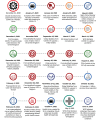Updated Surveillance Metrics and History of the COVID-19 Pandemic (2020-2023) in Europe: Longitudinal Trend Analysis
- PMID: 38568186
- PMCID: PMC11226935
- DOI: 10.2196/53551
Updated Surveillance Metrics and History of the COVID-19 Pandemic (2020-2023) in Europe: Longitudinal Trend Analysis
Abstract
Background: In this study, we built upon our initial research published in 2020 by incorporating an additional 2 years of data for Europe. We assessed whether COVID-19 had shifted from the pandemic to endemic phase in the region when the World Health Organization (WHO) declared the end of the public health emergency of international concern on May 5, 2023.
Objective: We first aimed to measure whether there was an expansion or contraction in the pandemic in Europe at the time of the WHO declaration. Second, we used dynamic and genomic surveillance methods to describe the history of the pandemic in the region and situate the window of the WHO declaration within the broader history. Third, we provided the historical context for the course of the pandemic in Europe in terms of policy and disease burden at the country and region levels.
Methods: In addition to the updates of traditional surveillance data and dynamic panel estimates from the original study, this study used data on sequenced SARS-CoV-2 variants from the Global Initiative on Sharing All Influenza Data to identify the appearance and duration of variants of concern. We used Nextclade nomenclature to collect clade designations from sequences and Pangolin nomenclature for lineage designations of SARS-CoV-2. Finally, we conducted a 1-tailed t test for whether regional weekly speed was greater than an outbreak threshold of 10. We ran the test iteratively with 6 months of data across the sample period.
Results: Speed for the region had remained below the outbreak threshold for 4 months by the time of the WHO declaration. Acceleration and jerk were also low and stable. While the 1-day and 7-day persistence coefficients remained statistically significant, the coefficients were moderate in magnitude (0.404 and 0.547, respectively; P<.001 for both). The shift parameters for the 2 weeks around the WHO declaration were small and insignificant, suggesting little change in the clustering effect of cases on future cases at the time. From December 2021 onward, Omicron was the predominant variant of concern in sequenced viral samples. The rolling t test of speed equal to 10 became insignificant for the first time in April 2023.
Conclusions: While COVID-19 continues to circulate in Europe, the rate of transmission remained below the threshold of an outbreak for 4 months ahead of the WHO declaration. The region had previously been in a nearly continuous state of outbreak. The more recent trend suggested that COVID-19 was endemic in the region and no longer reached the threshold of the pandemic definition. However, several countries remained in a state of outbreak, and the conclusion that COVID-19 was no longer a pandemic in Europe at the time is unclear.
Keywords: Albania; Andorra; Arellano-Bond estimators; Austria; Belarus; Belgium; Bosnia and Herzegovina; Bulgaria; COVID-19; Croatia; Denmark; Estonia; Europe; Finland; France; Germany; Greece; Greenland; Hungary; Iceland; Ireland; Italy; Latvia; Liechtenstein; Lithuania; Luxembourg; Moldova; Monaco; Montenegro; Norway; Poland; Portugal; Romania; San Marino; Serbia; Slovakia; Slovenia; Spain; Sweden; Switzerland; Ukraine; history of the pandemic; method of the moments; the Czech Republic; the Isle of Man; the Netherlands; the United Kingdom; the Vatican City.
©Alexander L Lundberg, Scott A Wu, Alan G Soetikno, Claudia Hawkins, Robert L Murphy, Robert J Havey, Egon A Ozer, Charles B Moss, Sarah B Welch, Maryann Mason, Yingxuan Liu, Lori A Post. Originally published in JMIR Public Health and Surveillance (https://publichealth.jmir.org), 21.06.2024.
Conflict of interest statement
Conflicts of Interest: None declared.
Figures




Similar articles
-
Surveillance Metrics and History of the COVID-19 Pandemic in Central Asia: Updated Epidemiological Assessment.JMIR Public Health Surveill. 2024 Aug 28;10:e52318. doi: 10.2196/52318. JMIR Public Health Surveill. 2024. PMID: 39013115 Free PMC article.
-
Updated Surveillance Metrics and History of the COVID-19 Pandemic (2020-2023) in Canada: Longitudinal Trend Analysis.JMIR Public Health Surveill. 2024 Dec 5;10:e53218. doi: 10.2196/53218. JMIR Public Health Surveill. 2024. PMID: 39471286 Free PMC article.
-
Surveillance of the Second Wave of COVID-19 in Europe: Longitudinal Trend Analyses.JMIR Public Health Surveill. 2021 Apr 28;7(4):e25695. doi: 10.2196/25695. JMIR Public Health Surveill. 2021. PMID: 33818391 Free PMC article.
-
Incidence of Lyme Borreliosis in Europe from National Surveillance Systems (2005-2020).Vector Borne Zoonotic Dis. 2023 Apr;23(4):156-171. doi: 10.1089/vbz.2022.0071. Vector Borne Zoonotic Dis. 2023. PMID: 37071405 Free PMC article.
-
Dietary Iron Intake in Women of Reproductive Age in Europe: A Review of 49 Studies from 29 Countries in the Period 1993-2015.J Nutr Metab. 2019 Jun 13;2019:7631306. doi: 10.1155/2019/7631306. eCollection 2019. J Nutr Metab. 2019. PMID: 31312532 Free PMC article. Review.
Cited by
-
Updated Surveillance Metrics and History of the COVID-19 Pandemic (2020-2023) in East Asia and the Pacific Region: Longitudinal Trend Analysis.JMIR Public Health Surveill. 2025 Feb 21;11:e53214. doi: 10.2196/53214. JMIR Public Health Surveill. 2025. PMID: 39804185 Free PMC article.
References
-
- Seyed Hosseini E, Riahi Kashani N, Nikzad H, Azadbakht J, Hassani Bafrani H, Haddad Kashani H. The novel coronavirus disease-2019 (COVID-19): mechanism of action, detection and recent therapeutic strategies. Virology. 2020 Dec;551:1–9. doi: 10.1016/j.virol.2020.08.011.S0042-6822(20)30172-0 - DOI - PMC - PubMed
Publication types
MeSH terms
LinkOut - more resources
Full Text Sources
Medical
Miscellaneous

